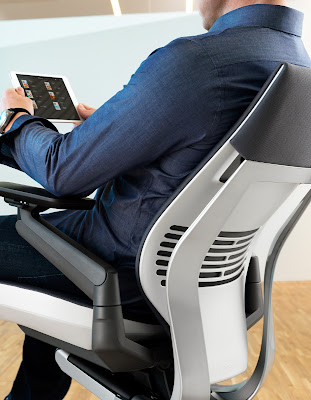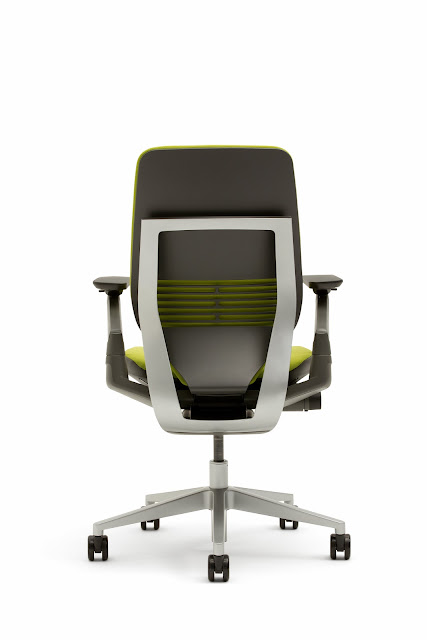STEELCASE BRINGS REVOLUTIONARY GESTURE TO INDIAN WORKPLACES
Inspired By Steelcase Global Study On New Postures Driven By Mobile Technology Company’s flagship Gesture Seating to Address Pain Caused by New, Unsupported Postures.
MUMBAI, NOVEMBER 22, 2013
Steelcase, the global leader in office furniture industry, unveiled Gesture world’s first ergonomic office chair designed to support one’s interactions with today’s technologies. Gesture was inspired by studying movements of the human body and created for the ways people work today. India is part of Steelcase’s global launch of Gesture.
“We love our technology – it’s become a ubiquitous extension of ourselves,” states James Ludwig, Vice President of Global Design for Steelcase. “The user interface is intuitive and responds to various gestures. But what about gesture recognition for the human body? The way technology impacts our bodies as we work has been largely ignored.”
Steelcase recently conducted a global study in 11 countries including emerging markets like China observing over 2000 people in a wide range of environments and postures. The study reveals how new technologies and new workplace behaviors have led to nine new postures -- not supported by current office chairs -- which frequently cause pain and long-term injuries, disrupting concentration and creativity. Gesture is designed in response to Steelcase’s global research about changing postures in the workplace. “Tablets were introduced just three years ago. But many people are using chairs that were designed well before these new devices became pervasive at work. Back then, chairs were created to help people hold one pose in front of a computer all day. Now we know that people need to move and change positions regularly, especially as they engage with new technologies. We observed people in pain -- they need a sitting experience designed for the ways we work today,” continued Ludwig.
.jpg) |
| Gesture |
Gesture: A Revolution in Sitting Experience for Workplaces
Steelcase researchers studied how the physiology of work has changed, how the human body interacts with new technologies and how it transitions as people shift from one device to another. Researchers noted a more extreme range of human sizes around the world, which impacts postures. The company also studied the changing sociology of work and how people rapidly shift between individual, focused tasks and creative collaboration. Each new activity caused people to change postures.
Based on this research, Steelcase designed Gesture’s three key interfaces – the core interface, upper limb interface and seat interface -- to support new postures driven by new technology and more casual behaviors in the workplace.
For example:
Gesture encourages motion rather than forcing the body to hold a single posture.
The upper limb interface allows people to draw closer to a work surface to avoid hunching over a screen and easily move close to the body to support texting postures.
Unlike conventional chairs, Gesture’s core interface hugs the lower back when people recline to scroll on a tablet screen.
The seat interface adjusts rapidly to help users avoid perching on the edge of their chair.
Gesture embraces a broad range of body sizes and easily adapts to meet the needs of each individual user, which is critical in an increasingly global business environment that has to support diverse workers than ever before.
Gesture is a system of interconnected parts – inspired by the human body – designed to support every movement.
“Today’s workers are driven by their vision – small technologies have a gravitational force to pull
the body down,” explained Carol Stuart Buttle, CPE, Principal at Stuart-Buttle Ergonomics.
“If the chair doesn’t move with the user, people slouch to make up for it, or flop on the desk to
overcompensate for what is uncomfortable. Workers today are moving from bad posture, to bad
posture, to bad posture. Gesture helps you be where you need to be – it helps workers find
support in smarter ways so they can use their devices in safer ways.”
9 Tech Driven Postures which inspired Gesture
As part of its global posture study, Steelcase identified nine new postures based entirely on the result of new technologies. For example:
The Draw
Technology (small and mobile) allows people to pull back from their desks while they use it. They recline, signaling they’re contemplating or absorbing information and draw the device closer to their body to maintain an optimal focal length.
The Multi-Device
This posture is representative of how people adapt to multitasking on multiple-devices. One hand holding a phone to the ear, the other tasking on a laptop. The result is a forward lean that is a symbol of concentration
and an orientation to the smaller screen of a laptop
The Text
Smartphones are small compared to other forms of technology and, therefore, require unique postures. Workers bring arms in close as keying and gesturing are performed
The Cocoon
People recline, bring up their feet onto the seat, and draw their smartphone or tablet close, resting on their thighs. The result is a cocoon – small mobile technology allows people to remain productive in this posture
The Swipe
This posture results when the device is used on a work surface in “surfing mode”, in which people operate the device with one hand, typically with swiping gestures. Because it’s on a work surface, a person must keep their head a certain distance above the tablet in order to see it, and position their head to look down at it.
The Smart Lean
This posture is the result of mobile devices that create the desire for people to temporarily “pull away” from others without leaving a meeting or collaborative environment. This is typically a temporary posture and used for glancing at incoming texts or e-mails.
The Trance
This posture was observed when people were focused on the screen and either mousing or using a touchpad to navigate on the screen for extended periods of time. This is a long duration posture.
The Take It In
In this posture, people recline to view content on the large display and/or sit back to contemplate. This posture is about “taking in” information rather than generating it.
The Strunch
The “strunch” (stretched-out hunch) is a very common posture with laptops. As people become fatigued, they gradually push their laptop further from the edge of the work surface, resting their weight on the surface. This causes them to reach forward to work. Since the back and neck cannot sustain the reach and hunch posture for a long time, the person begins to prop themselves up with their non- tasking arm.
Steelcase has established 3 WorkLife Centres in India – the company’s flagship showrooms in New Delhi, Bangalore and Hyderabad. Steelcase will be soon inaugurating its 4th Worklife Centre in Mumbai. Earlier in April 2013, the company started its first manufacturing facility in India spread across 50,000 square feet at Chakkan, Pune.
To try Gesture or learn more about the Steelcase Global Posture Study and Gesture please contact:
Allan Guan
+852 9272 6861
allan.guan@steelcase.com
Gesture will be available in early 2014.
About Steelcase Inc.
For 100 years, Steelcase Inc. has helped create great experiences for the world's leading organizations – wherever work happens. Steelcase and our family of brands – including Steelcase®, Coalesse®, Designtex®, Details®, Nurture®, PolyVision® and Turnstone® – offer a comprehensive portfolio of furnishings, products and services designed to unlock human promise and support social, economic and environmental sustainability. We are globally accessible through a network of channels, including approximately 650 dealers. Steelcase is a global, industry-leading and publicly traded company with fiscal 2013 revenue of $2.9 billion.
P.S All the images are provided by Steelcase and subject to copyright.
.JPG)










Posting Komentar